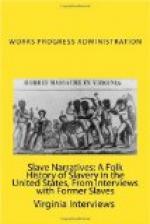“When a slave took sick she or he would have to depend on herbs, salves or other remedies prepared by someone who knew the medicinal value. When a valuable hand took sick one of the overseers would go to Upper Ville for a doctor.”
Maryland [—]-20-37 Rogers
James Calhart James, Ex-slave.
Reference: Personal interview with James Calhart
James, ex-slave,
at
his home, 2460 Druid Hill Ave., Baltimore.
“My father’s name was Franklin Pearce Randolph of Virginia, a descendant of the Randolphs of Virginia who migrated to South Carolina and located near Fort Sumter, the fort that was surrendered to the Confederates in 1851 or the beginning of the Civil War. My mother’s name was Lottie Virginia James, daughter of an Indian and a slave woman, born on the Rapidan River in Virginia about 1823 or 24, I do not know which; she was a woman of fine features and very light in complexion with beautiful, long black hair. She was purchased by her master and taken to South Carolina when about 15 years old. She was the private maid of Mrs. Randolph until she died and then continued as housekeeper for her master, while there and in that capacity I was born on the Randolph’s plantation August 23, 1846. I was a half brother to the children of the Randolphs, four in number. After I was born mother and I lived in the servants’ quarters of the big house enjoying many pleasures that the other slaves did not: eating and sleeping in the big house, playing and associating with my half-brothers and sisters.
“As for my ancestors I have no recollection of them, the history of the Randolphs in Virginia is my background.
“My father told mother when I became of age, he was going to free me, send me north to be educated, but instead I was emancipated. During my slave days my father gave me money and good clothes to wear. I bought toys and games.
“My clothes were good both winter and summer and according to the weather.
“My master was my father; he was kind to me but hard on the field hands who worked in the rice fields. My mistress died before I was born. There were 3 girls and one boy, they treated me fairly good—at first or when I was small or until they realised their father was my father, then they hated me. We lived in a large white frame house containing about 15 rooms with every luxury of that day, my father being very rich.
“I have heard the Randolph plantation contained about 4000 acres and about 300 slaves. We had white overseers on the plantation, they worked hard producing rice on a very large scale, and late and early. I know they were severely punished, especially for not producing the amount of work assigned them or for things that the overseers thought they should be punished for.
“We had a jail over the rice barn where the slaves were confined, especially on Sundays, as punishment for things done during the week.




